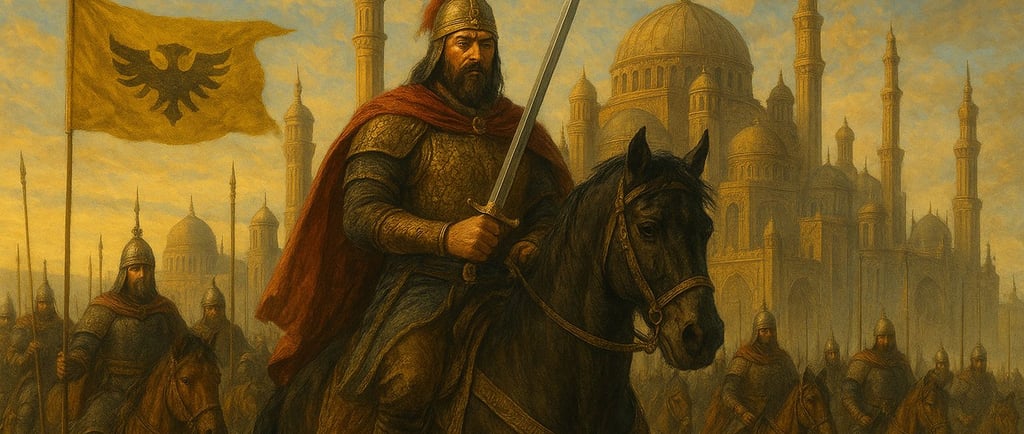The Rise and Fall of the Tartarian Empire's Monetary System: Lessons for Modern Investors
EDUCATION ON GOLD & SILVER


Introduction to the Tartarian Empire
The Tartarian Empire, often shrouded in mystery and speculation, is a historical entity believed to have existed in varying forms from the early medieval period until its decline in the 19th century. Encompassing vast regions across Eurasia, the empire's geographical reach extended from parts of Eastern Europe through Siberia and into Central Asia. Its emergence is typically marked around the 14th century, a time when significant cultural and political developments were taking place due to the influence of nomadic tribes and the establishment of trade routes such as the Silk Road.
The cultural significance of the Tartarian Empire cannot be understated. It was a melting pot of diverse ethnic groups and traditions, which contributed to a rich tapestry of socio-economic interactions. Various peoples within the empire, including Mongols, Turks, and Slavs, coexisted and influenced each other’s customs, languages, and arts. This cultural amalgamation laid the groundwork for a dynamic society that thrived on trade, agriculture, and craftsmanship.
Economically, the Tartarian Empire showcased a complex system that evolved over time. Initially driven by barter economies, the monetary system gradually transitioned into more structured forms involving the use of metals and sanctioned currencies. Several influential leaders played critical roles in this evolution, each promoting trade and coinage to facilitate transactions across the empire's expanse. The economy flourished largely due to its strategic position along vital trade routes, enabling the exchange of goods such as silk, spices, and precious metals.
With the rise of the Tartarian Empire's monetary system came the necessity for regulatory measures, leading to the establishment of a centralized economy under various leadership. However, as the empire began to face internal and external pressures, these foundational aspects would evolve, foreshadowing the eventual decline of its economic framework and, ultimately, the empire itself.
Key Leaders and Economic Events
The Tartarian Empire, a historical entity often shrouded in mystery, was influenced by several prominent leaders whose decisions shaped its economic landscape and monetary policies. One significant figure was Genghis Khan, known for his aggressive expansion and centralized control. Under his reign, the empire established a unified currency system, facilitating trade across vast territories. This innovative monetary approach paved the way for enhanced economic stability and increased commercial activity, which contributed to the empire's initial success.
Another pivotal leader was Kublai Khan, who further developed the financial infrastructure by introducing paper money as a means of promoting trade. His administration recognized the importance of facilitating commerce, and by endorsing a standardized currency, Kublai aimed to simplify transactions. This liberal monetary policy not only stimulated economic growth but also enhanced the empire's connectivity with neighboring regions, fostering a robust exchange of goods and resources. The strategic initiatives taken by these leaders played a crucial role in establishing a resilient economic environment.
Key economic events during the Tartarian Empire also influenced its financial system significantly. The Silk Road, a crucial trade network, facilitated not only the exchange of commodities but also the interplay of cultures and ideas. This event marked the empire’s golden age in trade, contributing to wealth accumulation and increased market interactions. Furthermore, resource allocation decisions directly impacted the empire's prosperity; leaders skillfully managed agricultural production and mineral extraction, ensuring an efficient distribution that met the empire's growing demands.
The interplay of visionary leadership and strategic economic initiatives ultimately shaped the rise and fall of the Tartarian monetary system. Understanding these historical precedents offers valuable lessons for contemporary investors regarding the importance of leadership in economic systems and the critical role of pivotal events in shaping financial landscapes.
The Role of Precious Metals: Gold and Silver
The monetary system of the Tartarian Empire prominently featured precious metals, particularly gold and silver, which played an essential role in trade and the measurement of wealth. These metals served not only as a medium of exchange but also functioned as a store of value, providing stability in a period marked by significant economic fluctuations. Gold, recognized for its rarity and intrinsic value, became synonymous with currency. Silver complemented this by offering a more accessible form of monetary exchange for everyday transactions, reflecting a broader egalitarian approach to commerce.
The historical practices surrounding the use of precious metals in the Tartarian Empire underscore their influence on economic stability. Unlike fiat currencies, which can be subject to inflation and government manipulation, gold and silver are tangible assets recognized across cultures and eras. This trust in their value fundamentally contributed to a robust trading environment that facilitated commerce both within the empire and with external partners. Markets thrived where gold and silver formed the backbone of exchange, underpinning economic activities and fostering greater financial integrity.
In light of today’s economic landscape, the lessons derived from the Tartarian Empire’s approach to precious metals remain relevant for modern investors. The current monetary systems continue to grapple with volatility, prompting investors to seek safe havens for their assets. Gold and silver are increasingly viewed as solutions to hedge against inflation and currency devaluation. In contemporary times, their utility extends into diversifying investment portfolios, offering investors a buffer in uncertain economic situations. By understanding the historical precedent set by the Tartarians, modern investors can derive valuable insights into the enduring significance of gold and silver as monetary instruments that promote economic stability and trust.
Lessons for Modern Financial Futures
The rise and fall of the Tartarian Empire serves as a rich historical case study from which modern investors can extract valuable lessons. One prominent aspect of this empire's monetary system was its reliance on precious metals, particularly gold and silver, which not only served as currency but also as stores of value during times of uncertainty. Investors today can greatly benefit from recognizing the inherent stability these assets provide amidst fluctuating economic conditions. By diversifying portfolios to include precious metals, individuals may shield their investments against inflation or potential market downturns, much like the Tartarians did during their prosperous times.
Understanding the historical context of monetary systems, such as that of the Tartarian Empire, enables investors to identify recurring economic patterns that persist in today's markets. Lessons learned from past financial mishaps, such as over-dependence on fiat currency and the dangers of excessive speculation, highlight the necessity for conservative investment strategies. For instance, maintaining a level of liquidity and ensuring a balanced asset allocation can mitigate risks associated with sudden market changes. Drawing parallels with the decline of the Tartarian monetary system, modern investors should take caution against the pitfalls of unregulated financial practices that may lead to severe economic consequences.
Furthermore, a keen awareness of historical cycles can empower current investors to make informed decisions. By analyzing the factors contributing to the rise and subsequent fall of the Tartarian Empire—such as geopolitical shifts, resource mismanagement, and external pressures—investors can better navigate the complexities of today's global markets. The emphasis on strategic planning and prudent investment choices remains relevant, as economic landscapes continue to evolve. By integrating these historical insights with contemporary financial strategies, investors may enhance their potential for success in an ever-changing economic environment.
